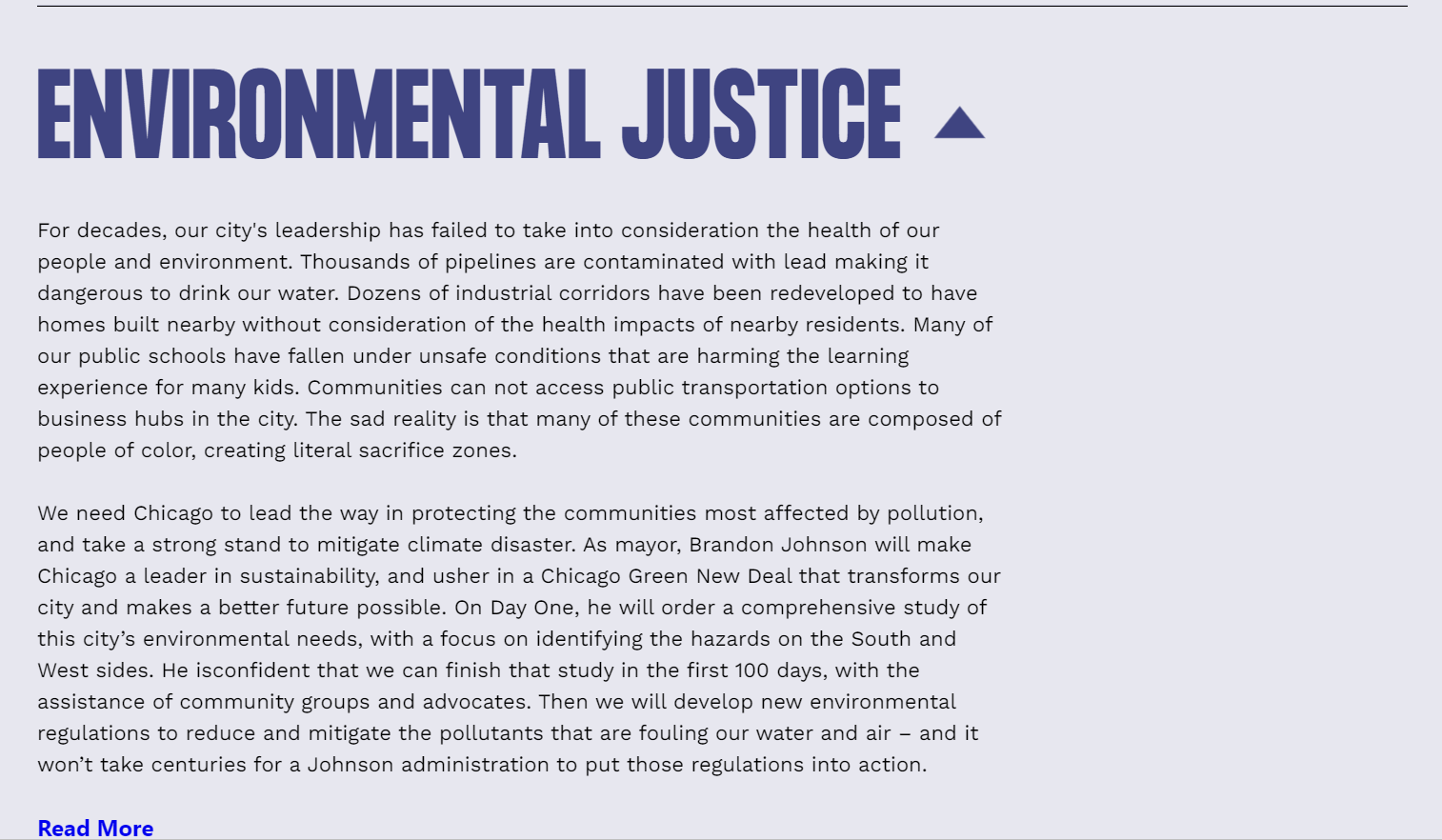After winning the Chicago runoff election, Brandon Johnson promised to be better than former mayor Lori Lightfoot — but can he pull it off?
With a promise of a greener Chicago, Johnson is encouraging Chicagoans that by the end of his term, he will offer even more than promised by Lightfoot. However, citizens are left wondering —– can he keep his promise?
Chicago has a larger impact on the environment than many other areas of Illinois due to its large population. According to a survey from the U.S. Conference of Mayors and the Center for Climate and Energy Solutions Future from 2017, the positive or negative environmental purchasing power of responding cities alone is significant. These cities spend more than $1.4 billion on total electricity and procure more than 11,500 total vehicles every year. It is abundantly clear that the spending power of cities — and the power for change — is growing faster than ever due to these greener solutions.
Despite the massive spending power they hold, big cities are consistently falling short on their climate action plans, despite the public’s constant outcry. The lack of movement within local government to create an improved climate action plan has infuriated the public.
Citizens are pushing for more action than ever before, especially after the lack of federal action taken. DePaul environmental science major Sydney Bosely explained that local action is an effective method of change.
“At the federal level it’s very difficult to get anything done, so local action is some of the most important action we can take. I think local action is where we will see the most action when it comes to climate action,” said Bosely.
Former mayor Richard M. Daley spent much of his time in office attempting to reverse the negative mindset surrounding climate action, using the city’s spending power for a greener Chicago. As one of Chicago’s leading green policy makers, Daley spent much of his term implementing new infrastructure to reduce carbon emissions and pollution caused by the city.
The city first implemented its sustainable development policy in 2004, under Mayor Daley. Since then, mayors have followed suit: green roofs have been installed, coal plants have been grandfathered out and green permits have been issued. However, when Lightfoot came into office with a promise to change Chicago’s climate for the better, voters were quickly disappointed.
After Lightfoot released her climate action plan in 2022, voters were optimistic about the mayor’s plan for the city. Equipped with a brand-new plan focused on economic and ecological equity, even climate enthusiasts were optimistic. DePaul’s chair of the Department of Environmental Studies, Mark Potosnak, commented on the relationship between equity and environment.
“There is a link between social and environmental justice. If you are going to fix our environmental problems and also our social problems, you can’t do those independently,” said Potosnak.
After months of inaction from the former mayor, voters were left confused; empty promises had voters feeling on edge as they entered the next mayoral election. Lightfoot’s lack of commitment to her green promises aided in her quick departure from office as voters found the importance in local climate action.
In contrast, Brandon Johnson entered his campaign with a strong promise to do everything Lightfoot could not follow through with. Johnson has made a strong effort to begin showing the city that he understands the impact they are feeling from climate change. Working in tandem with the state government, Johnson promises a just transition to attacking climate issues ranging from clean air and drinking water, to a stronger Department of Environment.

Johnson’s Environmental Justice plan via https://www.brandonforchicago.com/on-the-issues
While Johnson plans to make larger changes within the city, he still has to abide by state regulations. Illinois has taken steps to be a greener state in the past few years. In 2021, Governor J.B. Pritzker signed the Climate and Equitable Jobs Act into law. The plan will work in tandem with much of what Johnson has run on, giving Illinois workers cleaner jobs and growing the clean- energy economy.
Mayor Johnson ran on the promise of a “Green New Deal,” a promise many Chicagoans are familiar with from former Mayor Richard M. Daley. Johnson’s plan sits on the promise of environmental justice. This promise has some city occupants excited for a brighter future. Environmental enthusiast Jamie Kollman feels that environmental legislation is important regardless of where you live.
“Living in the Midwest you don’t hear a lot of environmental legislatures. It’s incredibly important because we are feeding the world in many ways and local government needs to reflect that,” said Kollman.
While Johnson’s term is still in its infancy, he seems to have high hopes for the city. According to his official website, Johnson is planning to simultaneously attack high- and low- priority climate problems such as clean drinking water, housing and transportation.
Johnson also plans to work in tandem with the state government to provide clean jobs for workers in Chicago. His plan to create new jobs in the city could promote cleaner working conditions as well as a flourishing economy — a Chicago many people have been looking forward to for years.
Due to Lightfoot’s lack of action, residents are hesitant to believe Johnson’s promise to have a cleaner Chicago by 2040. Potosnak noted the timeline was extensive.
“2040 is a long time away, it is a lot of hard work. It requires money, education, and commitment and it will be a long process,” said Potosnak.
Potosnak shares the same sentiment as many Chicago voters. The track to a cleaner Chicago is a long and tedious one that many Chicagoans are wary of because of the length of Johnson’s plan. However, there are many who understand the importance of local government and aim to educate others on why this process is so tedious.
This education could potentially make or break Johnson’s success throughout his term as mayor, but this can be increasingly difficult. As an avid climate enthusiast, Kollman is constantly looking for ways that political figures are following up on their policies. She noted that she is especially optimistic.
“When I hear about these people coming to schools or organizations that reflect the things that they value … to see how these things actually work and actually talk to people who deal with this on a daily basis,” said Kollman.
Lightfoot’s communication to the public fell short and ultimately contributed to her downfall. While being a public figure can come with its difficulties, it is vital to stay transparent with the public.
“The baseline is to follow up on what he says he is going to do … Even if he makes a move to start the process, he says he is going to get done … and show the people he is trying instead of saying all these things to get elected and doing nothing about it,” Bosely said.
Johnson’s plan has impressed many voters, with thorough descriptions of his plan to create a greener Chicago. Voters are still hesitant but optimistic about the new mayor’s plan for the state. The importance of local government is as crucial as ever in today’s climate crisis. Climate action has to be worked on at every level for it to have any effect on the environment.
Much of the optimism of voters comes from the views of intersectionality that Johnson has been able to clearly communicate to the public. The connection between the environment and social issues is irrefutable and vital for a policymaker to see. Voters are looking for someone who can see past the divide to tackle these two problems at once.
“The promising thing is that he will be very well attuned to the connection between social issues and environmental issues. Daley didn’t necessarily see the intersectionality,” Potosnak said.
This clear view of intersectionality has had many Chicago voters optimistic that Johnson will do what Lightfoot couldn’t.

Brandon Johnson speaking to supporters after winning the Mayoral Election on April 4, 2023. Photo by Hailey Bosek
The bottom line for Chicago voters is a communicative, optimistic and driven mayor. Chicagoans are far past the years of waiting for change to happen. More than 96 percent of cities are feeling the effects of climate change according to the 2020 survey by the U.S. Conference of Mayors and the Center for Climate and Energy Solutions.
Voters are ready for a new Chicago and Johnson seems to promise exactly that.
“I just hope that this term changes things for Chicago and pushes it in a better direction,” Bosely said.
While climate action can take years, Johnson’s commitment to a short- and long-term plan provides some optimism for citizens. Dedication to a greener city starts with short term action — something many politicians forget when creating a climate action plan. With hope, Johnson’s passion for climate equity will push Chicago (and other large cities) to recognize their impact and make a change.
Many Chicago voters are feeling the same as Bosely. There is no certain way for the public to know if Johnson will follow through on his climate plans. For now, all we can do is sit, wait and continue to fight for a cleaner Chicago.
Header by Julia Hester




NO COMMENT